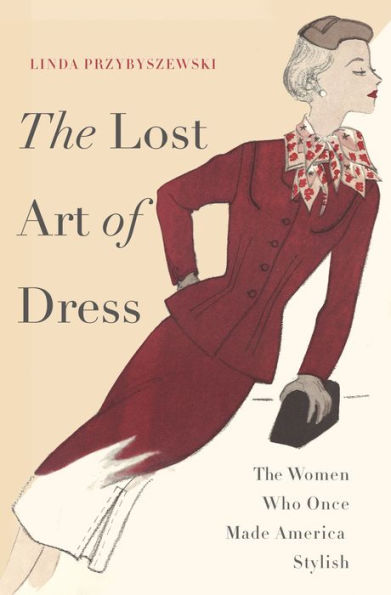03/03/2014
Both a history and a defense of home economics, this book follows the Dress Doctors, a group of female teachers and writers whose mission, starting in the mid-19th century, was to help women assemble budget-conscious wardrobes with a sense of art and occasion, utilizing rules about color, decoration, and appropriateness. Przybyszewski, a University of Notre Dame historian and prize-winning dressmaker, leaves little doubt as to her opinion of fashion after home economics departments and classes were dismantled in the 1960s: “If the Dress Doctors looked around at womankind today, they would wonder why so many of us are determined to appear ready to seduce at all hours of the day.” The author unabashedly addresses the irony of miniskirts (especially in the workplace) as an infantalization of women during the feminist revolution. Finally, she argues for a return to the teaching of sewing: “the American Association of University Women girls to work with their hands in grade school and junior high… why not sewing?” The author can be critical of the Dress Doctors, who, for example, virtually ignored African-Americans and other minorities, but she effectively argues that women might do well with a more traditional concept of fashion. 31 b&w images and two color inserts. Agent: Geri Thoma, Writers House. (Apr.)
"A fascinating and valuable book."—Boston Globe
"The writing is sharp; the research thorough; and the book's illustrations a lone are worth the price of entry."—Books & Culture
"A fascinating read.... Highly recommended!"—A Dress A Day
"An important, even revolutionary book."—Acculturated
"Like another forgotten artifact, the hope chest, her...book is most delightfully and fragrantly packed."—New York Times Book Review
"A witty look at well-dressed women and a defense of the classic home-economics course."—Columbus Dispatch
"If you love history as much as sewing, or are fascinated by the sewing the style manuals of the past, pick up a copy of The Lost Art of Dress."—Threads Magazine
"[Przybyszewski's] wit and intelligence make this book as entertaining as it is informative."—Shop the Garment District blog
"Linda Przybyszewski's remarkable, enchanting, well-researched history of America at its most stylish reminds us that once upon a time we were classy and fabulous."—Karen Karbo, author of The Gospel According to Coco Chanel
03/15/2014
In this exhaustively researched book, Przybyszewski (U.S. history, Univ. of Notre Dame) chronicles the early 20th-century work of numerous American women she dubs the Dress Doctors. Their mission was better living through fashion—not by pushing trends but by applying common sense and principles of art to personal style. She sets fascinating sociological scenes, including the rise and fall of the girdle, the custom of dressing for dinner, and the demise of home economics departments in universities. Przybyszewski—who teaches a dress-history class called "Nation of Slobs"—sometimes adopts an "everyone dressed better back then" tone, though every age has frumps and follies alongside enduring styles. The dress doctors, varied as their tastes were, argued that wearing clothing well is work with tangible rewards. A well-dressed woman chooses apparel for the lifestyle and body she has, not those she wishes she had, and reaps the benefits of comfort in her own skin—a look that's always in style. The author's spotlight on the women's work, with its extensive endnotes (though relatively few illustrations), will appeal to scholars of women's history and American culture as well as fashion. VERDICT This entertaining read is funny, opinionated, and full of useful wisdom—much like the dress doctors themselves.—Lindsay King, Yale Univ. Libs., New Haven, CT
2014-03-16
Historian and prizewinning dressmaker Przybyszewski (History/Univ. of Notre Dame; The Republic According to John Marshall Harlan, 1999, etc.) recounts the social history of a group of talented women, the "Dress Doctors," who once instructed young American women in the art of dress. While the author bemoans American women's current sloppy attire, her illuminating commentary explains the sewing and design skills that were once common knowledge but have been washed away by a proliferation of cheap, ill-fitting and inappropriate clothing. Consequently, American women no longer possess the aptitude necessary to dress with style on a reasonable budget. Ambling through a used bookstore, Przybyszewski discovered a 1954 college textbook whose "message was artistic, logical, and democratic: knowledge, not money, is the key to beauty in dress." A "remarkable group of women who worked as teachers, writers, retailers, and designers" wrote these texts, and many worked in home economics departments at colleges. The Dress Doctors based their theory of dress on the "Five Art Principles": harmony, rhythm, balance, proportion and emphasis. Przybyszewski delves into the role of self-esteem, the turning away from thrift as an ideal, and the rise of consumption in America and its effects on the country. When the 1960s brought waves of social, legislative and cultural upheavals, the Dress Doctors began losing their hold on fashion. Miniskirts and pants were becoming the norm for many girls and women. By 1975, one Dress Doctor declared, the "bad was beautiful and the beautiful was worthless." The author also explores the inherent racism of the Dress Doctors' teachings. "The one type of woman the Dress Doctors overlooked completely was the African American," she writes. "They thereby implied, even if they never actually wrote it down, that she could not be beautiful." Przybyszewski's fashion history shines a much-needed spotlight on a contingent of forgotten professionals and the role they played in dressing American women with style.



